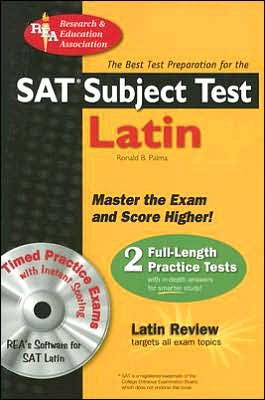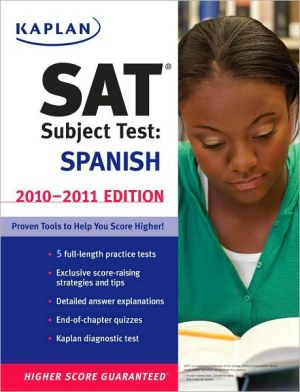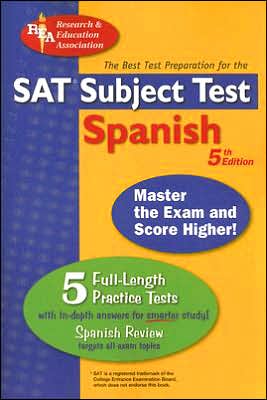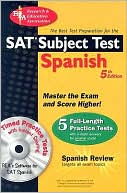SAT Subject Test Latin
REA's TESTware edition of SAT Latin covers all language areas to appear on the actual exam including in-depth coverage of declensions, conjugations, grammar, verb tenses, and more. The book features 2 full-length practice exams, which are also on CD-ROM in a computerized, timed format with instant scoring. Each practice exam question is fully explained for a better understanding of the subject material. Follow up study with REA's proven test-taking strategies, drills, and study schedule that...
Search in google:
Master the SAT Subject Test in Latin and score higher! Our test experts show you the right way to prepare for this important college exam. REA's all-new edition of SAT Latin covers all language areas to appear on the actual exam including in-depth coverage of declensions, conjugations, grammar, verb tenses, and more. The book features 2 full-length practice exams. Each practice exam question is fully explained to help you better understand the subject material. Follow up your study with REA's proven test-taking strategies, powerhouse drills and study schedule that get you ready for test day.
Whether you are a Latin II, III, or IV student, you are to be congratulated for putting your knowledge of Latin on the line by taking the SAT Latin Subject Test! This book is designed to help you strengthen your specific weaknesses and to facilitate a comprehensive review of all that you've learned. Inside you will find targeted information about the exam, as well as tips on how best to prepare for it.\ About the SAT Latin Subject Test\ Who Takes the Test and What Is It Used For?\ Students planning to attend college should take the SAT Latin Subject Test if:\ (1) They have studied Latin and any of the colleges they apply to require SAT Subject Tests for admission;\ OR\ (2) The student wishes to demonstrate proficiency in Latin.\ The SAT Latin Subject Test is designed for students who have a wide-ranging knowledge of Latin. Recommended preparation includes two to four years of Latin study in high school.\ Who Administers the Test?\ The SAT Latin Subject Test is developed by the College Board and administered by Educational Testing Service (ETS). The test development process involves the assistance of educators throughout the country, and is designed and implemented to ensure that the content and difficulty level of the test are appropriate.\ When Should the SAT Latin Test be Taken?\ If you are applying to a college that requires SAT Subject Test scores as part of the admissions process, you should take the SAT Latin Subject Test toward the end of your junior year or at the beginning of your senior year. If your scores are being used only for placement purposes, you may be able to take the test in the spring of your senior year. For more information, be sure to contact the colleges to which you are applying.\ When and Where is the Test Given?\ The SAT Latin Subject Test is administered twice a year at many locations throughout the United States; most test centers are at high schools. For more information on specific testing dates and locations, consult the registration bulletin or your high school guidance counselor.\ To receive information on upcoming administrations of the exam, consult the publication Taking the SAT Subject Tests, which may be obtained from your guidance counselor or by contacting:\ College Board SAT Program PO Box 6200\ Princeton, NJ 08541-6200\ Phone: (609) 771-7600\ E-mail: sat@info.collegeboard.com Web site: http://www.collegeboard.com\ Is There a Registration Fee?\ Yes. There is a registration fee to take the SAT Latin Subject Test. Consult the publication Taking the SAT Subject Tests for information on the fee structure. Financial assistance may be granted in certain situations. To find out if you qualify and to register for assistance, contact your academic advisor.\ Content and Format of the Test The SAT Latin Subject Test is a one-hour exam consisting of approximately 70 multiple-choice questions. Each question has four answer choices, lettered (A) through (D). The questions are organized into six categories (Parts A-F in the following table).\ Skills Tested Approximate Percentage of Score Number of Questions Grammar & Syntax (Parts A, D, and E) 30 20\ Derivatives (Part B) 5 4-5\ Translation (Part C) 20 14\ Reading Comprehension (Part F) 45 30-35\ The parts that follow are arranged in the sequence of their appearance on the exam. Questions in each part are arranged in order of difficulty, easy to difficult.\ PART A: Recognition of Forms Select the specific grammatical form (noun, pronoun, adjective, adverb, and verb) of a Latin word. Eight questions.\ PART B: Derivatives Pick the Latin root word of the English derivative given in context. Four questions.\ PART C: Translation Discriminate the correct meaning of Latin to English sentences or parts of sentences. Fourteen questions.\ PART D: Sentence Completion Complete the Latin sentence by choosing the correct Latin form. Seven questions.\ PART E: Syntax Substitution Choose an alternate way of expressing the same thought in Latin (substitution, e.g. participial phrase for relative clause). Five questions.\ PART F: Reading Comprehension Answer English questions on short passages of adapted Latin (about eight lines). There are three to five sight passages, including one of verse. Uncommon words are glossed. This section includes questions on specific points of grammar and scansion of the first four feet of the dactylic hexameter. Five to 15 questions per passage.\ About This Book\ This book will provide you with an accurate and complete representation of the SAT Latin Subject Test. Inside you will find a course review designed to provide you with the information and strategies needed to do well on the exam, as well as two full-length practice tests based on the actual exam. REA's practice tests contain every type of question you can expect to encounter on the SAT Latin Subject Test. Following each test, you will find an answer key with detailed explanations to help you master the test material.\ Some Special Features Here are some special features of this book:\ o Informal style that talks directly to you with your needs in mind, to make you feel comfortable o Periodic interjection of humor, to keep you in good spirits o Analysis of the content and format of the exam, to give you insight o References to currently available College Board exam materials, to inform you o Glossaries of terms commonly used in the study of Latin, to help you understand o Quick-study tables that consolidate major concepts, to help you summarize o Easy-to-use organizational style, to help you find your way o Clear and simple explications of forms and their uses, plus memory devices, to help you recall o Unadapted and adapted sententiae and passages from Roman literature, to make readings authentic o Questions in each chapter that simulate the format and content of those on the exam, to help you gauge your progress o Stumper and Ambush questions, to challenge you o Detailed explanations of answers to questions, to help you learn from your mistakes o Webliographies of additional resources, to extend your review o Two complete practice exams, to help you assess your readiness\ How This Book is Organized The content of this book is divided into sections and chapters, which are further subdivided into segments that contain notes on finer points of the content. The stated purpose of the SAT Latin Subject Test is to evaluate your ability to read Latin. Because the test evaluates your mastery of the mechanics of reading Latin, with special emphasis on grammar and syntax, the majority of the presentations in this book are devoted to helping you review Latin forms and their uses. These sections are therefore organized according to the parts of speech recommended for review by the College Board, namely, nouns, pronouns, adjectives, adverbs, and verbs:\ Section 1: The Basics Section 2: Nouns Section 3: Pronouns Section 4: Adjectives and Adverbs Section 5: Indicative Verbs Section 6: Imperative Verbs Section 7: Verbals Section 8: Subjunctive Verbs Section 9: Special Aspects of the SAT Latin Subject Test Section 10: Practice Tests\ Most chapters begin with a reference chart of Latin forms (everyone's favorite!), which is accompanied by a brief discussion of the most common uses of these forms. In these presentations, alternative nomenclature is provided when forms or uses are labeled or described; for example, purpose clauses are also referred to as final clauses. Traditional terms, such as "passive periphrastic," are used for convenience. Glossaries of terms are included at appropriate points in this book, but by no means should this suggest that you will be tested on terminology, which is simply a means to the end of reading and understanding Latin, and not an end in itself.\ The presentations in each chapter have been designed to supplement your preparation, whether you have learned Latin using the grammar-translation method (e.g., Amsco's Lingua Latina, "Jenney" First Year Latin and Second Year Latin, Latin for Americans, Our Latin Heritage) or the reading-based method (e.g., The Cambridge Latin Course, Ecce Romani, The Oxford Latin Course). Use this review guide to supplement the text from which you learned Latin because the latter is the resource with which you will be most familiar. Illustrative Latin sentences with English translations are provided to support the presentations in each chapter. These sentences reflect cultural and literary themes appropriate to the intermediate level of study. The presentation in each chapter ends with a quick-study condensation, followed by practice questions covering the content of that chapter. These questions simulate the styles of questions on the various parts of the actual exam, such as recognition, completion, and translation. A "Stumper" question that will challenge your mastery is included at the end of each set of practice questions. Occasionally, you will come across an "Ambush" question that will evaluate your continuing command of the material from a previous chapter or chapters. The answers to all practice questions are provided and discussed, with references back to the content of the chapter.\ In the final section, you will find chapters on parts of the exam that warrant special attention by virtue of the style of their questions, such as syntax substitution, which is the replacement of one Latin word or expression with another that has equivalent meaning. Separate presentations on translation and reading comprehension are provided in the final chapters.\ As you make your way through this book, please make liberal use of the various reference tools provided, such as the quick-study reviews within individual chapters and sections, as well as the table of contents; the section, chapter, and segment headings; the back-referencing notations that appear in the discussions of the answers; and the index. This "connective tissue" will help you to move about easily in the book so that you can reinforce what you do know and repair what you do not. The content and organization of each section and chapter are designed to lead you to eventual success on the complete practice tests provided at the end of this book and thus to success on the SAT Latin Subject Test. Io triumphe!
CONTENTSAbout the Author Acknowledgments About Research & Education Association SECTION 1: The Basics Chapter 1: Excelling on the SAT Latin Subject Test Chapter 2: Vocabulary and Derivation Chapter 3: Grammar and Syntax SECTION 2: Nouns Chapter 4: The Language of Nouns Chapter 5: The Forms of Nouns Chapter 6: The Nominative Case Chapter 7: The Genitive Case Chapter 8: The Dative Case Chapter 9: The Accusative Case Chapter 10: The Ablative Case and the Locative Case SECTION 3: Pronouns Chapter 11: Demonstrative Pronouns Chapter 12: The Relative Pronoun and the Interrogative Pronoun Chapter 13: Indefinite Pronouns Chapter 14: Personal Pronouns Chapter 15: Reflexive and Intensive Pronouns SECTION 4: Adjectives and Adverbs Chapter 16: Adjectives Chapter 17: Adverbs SECTION 5: Indicative Verbs Chapter 18: The Language of Verbs Chapter 19: Forms of the Indicative: Active and Passive Voice Chapter 20: Deponent Verbs Chapter 21: Irregular Verbs Chapter 22: Impersonal Verbs SECTION 6: Imperatives Chapter 23: Direct Address: Commands, Direct Questions, and the Vocative Case SECTION 7: Verbals Chapter 24: Participles Chapter 25: The Gerund, the Gerundive, and the Supine Chapter 26: Infinitives SECTION 8: Subjunctive Verbs Chapter 27: Forms of the Subjunctive Chapter 28: The Subjunctive Used Independently Chapter 29: Conditional Sentences Chapter 30: Subordinate Clauses with Ut Chapter 31: Subordinate Clauses with Q-Words Chapter 32: Subordinate Clauses with Cum SECTION 9: Special Aspects of the SAT Latin Subject Test Chapter 33: Syntax Substitution Chapter 34: Translation Chapter 35: Reading Comprehension Chapter 36: Scansion SECTION 10: Practice Tests Practice Test 1 Practice Test 2 Answer Sheets Index Quick Study Guide Ablative Absolute Adjectives Comparison of Irregular Adjectives and Adverbs Comparison of Regular Adjectives and Adverbs Conditional Sentences Cum Clauses Dependent Clauses Derivation Resources (Online) Expressions of Purpose Gerunds and Gerundives Grammar and Syntax Glossary Grammar and Syntax Resources (Online) Independent Subjunctives Indicative Verbs, Active and Passive Indirect Expressions Indirect Statement Infinitives Irregular Verbs Meter and Scansion Resources (Online) Noun Forms Noun Syntax Nouns Glossary Participles Pronouns Q-Clauses Sequence of Tenses Subjunctive Verbs, Active and Passive Time Clauses Ut Clauses Verbs Glossary Vocabulary Resources (Online) Wheelocks Latin Resources (Online)





